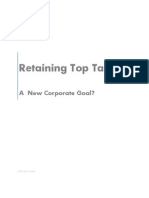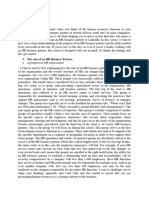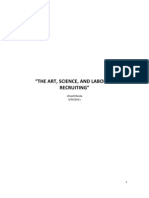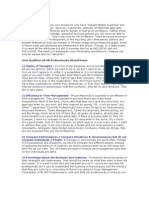Employee Retention
Employee Retention
Uploaded by
saiponnaCopyright:
Available Formats
Employee Retention
Employee Retention
Uploaded by
saiponnaCopyright
Available Formats
Share this document
Did you find this document useful?
Is this content inappropriate?
Copyright:
Available Formats
Employee Retention
Employee Retention
Uploaded by
saiponnaCopyright:
Available Formats
1
WHITE PAPER
Employee Retention
How to keep the keepers and maintain
optimal turnover levels
JUNE 2010
2
WHITE PAPER: EMPLOYEE RETENTION: HOW TO KEEP THE KEEPERS AND MAINTAIN OPTIMAL TURNOVER LEVELS
Retention is a business issue
and losing one or two key
people can have a signicant
impact on your longevity or
protability.
Introduction
For many of the worlds most admired companies,
the ability to attract and retain talented employees
was the single-most reliable predictor of excellence,
according to Fortune magazine. And it may be the
single-most important challenge of this decade.
Why care about retention? Retention is a business
issue and losing one or two key people can have a
signicant impact on your longevity or protability.
In the following white paper, we outline how
managers can determine whom to keep, how to
treat those who leave and what to do to retain those
necessary to the organization.
These lessons are worth learning because:
Most organizations dont know who is valuable
and who isnt
Organizations lack processes and tools to
effectively restructure or downsize
It is extremely challenging to retain and motivate
the survivors
Decisions must be made quickly
Processes must be humane, but risk must be
mitigated as well
Resources are limited
Know who to keep and who to lose: 3 tools
The rst thing to think about in guring out who to
keep is your desired attrition. Is it ten percent? Fifteen
percent? Zero? If the latter, then you need to take
actions to ensure you dont lose anyone.
But if some turnover is OK, whom can you afford to
lose? This is a more likely scenario than zero, so you
need to take a look at your workforce and the people
in it.
Uniqueness Grid
The uniqueness grid is designed to differentiate
human capital and its competitive advantage. Or in
other words, the specialized skills of your workers
versus the value to your organization.
This is a relatively new concept in human resources
that is based on the principle that you should not
treat everyone the same way. Not everyone has the
same skill set and not everyone can provide the
competitive advantage you need.
3
WHITE PAPER: EMPLOYEE RETENTION: HOW TO KEEP THE KEEPERS AND MAINTAIN OPTIMAL TURNOVER LEVELS
Examples:
You may have a person with highly-specialized
skills, but these skills arent unique to your
business. Perhaps those are the jobs that you
outsource so it doesnt become a retention issue.
On the other hand, you may have a person with
unique skills as well as a competitive advantage,
such as a software designer who has certain
intellectual knowledge critical to your business.
Finally, you may have operational partners
people whose skills are less unique but who are
critical to running your business operations. They
too provide a competitive advantage.
Performance Potential
Another assessment is the performance-potential.
This is used to look at the leadership potential of
your employees the potential to take on larger
responsibilities. You dont want to lose your stronger
performers who score high in the leadership potential
area, but you also may not want to lose those who
have already demonstrated leadership but who may
only be mid-level performers.
You dont want to lose your
stronger performers who
score high in the leadership
potential area, but you
also may not want to lose
those who have already
demonstrated leadership but
who may only be mid-level
performers.
Differentiating Human Capital
Competitive Advantage Value of Human Capital Low
H
i
g
h
U
n
i
q
u
e
n
e
s
s
o
f
H
u
m
a
n
C
a
p
i
t
a
l
Professional Partners Strategic Capabilities
Contract Candidates Operational Partners
4
WHITE PAPER: EMPLOYEE RETENTION: HOW TO KEEP THE KEEPERS AND MAINTAIN OPTIMAL TURNOVER LEVELS
Risk of Leaving
Finally, you want to take the data youve gathered
and look at it within the matrix called risk of leaving.
On a simple grid you can plot those who are most
valuable to the company high, medium, or low
against the risk of leaving high, medium, or low.
Bottom line: Business leaders think about these
factors uniqueness, performance, potential and
value because understanding them leads to the
desired actions necessary to properly retain people.
Best practices need to be relevant to
your industry.
Who Must We Keep/Lose?
Likely Potential Current Performance
Bottom 10% Middle 70% Top 20%
Top - 20% TURN 4 2 1
Meets - 70% GROWTH 7 5 3
Bottom - 10% MASTERY 9 8 6
Plotting Whos at Risk
Value to Business Risk of Leaving
Low Medium High
HIGH
MEDIUM
HIGH
Business leaders think about
these factors uniqueness,
performance, potential
and value because
understanding them leads to
the desired actions necessary
to properly retain people.
5
WHITE PAPER: EMPLOYEE RETENTION: HOW TO KEEP THE KEEPERS AND MAINTAIN OPTIMAL TURNOVER LEVELS
How to treat those who leave and those
who remain
The way you treat people when they leave a
company voluntarily or through a reduction in
force (RIF) impacts retention. In short, one of the
keys to retention is how you treat those who exit. Its
necessary to be respectful and fair, to make the cut as
clean as possible instead of doing it multiple times.
Your treatment of the people who are asked to
leave is going to be weighed by those who remain.
If you make multiple layoffs, those people as well
as people outside your organization are going to
wonder whats going on with your company. You
must work hard to build trust and respect among
those who are left. This means not hiding the facts. If
you do, you will be found out at some point.
To prepare for a RIF, dot your Is and cross your
Ts. Have your business rationale at hand, your
selection criteria developed, your managers
trained, your severance packages ready and your
succession planning in place. You want to execute
simultaneously with precision but with humanity.
Treat people with respect dont notify them with an
impersonal e-mail or conference call. Communicate
openly and truthfully.
How to structure an effective retention policy
A lot of thought goes into who gets retained and who
isnt but remember to think about retention policies
for the long-term. Employee retention and the
intellectual capital within your workforce is critical
to success.
Research has shown that the reasons people leave
employers are very different from the reasons they
stay. The exit interviewee may say Ive found another
job, or the pay is better, but nine times out of 10,
those arent the reasons the person started looking
around in the rst place. The reason they start looking
is because they dont feel appreciated.
One of the keys to retention is
how you treat those who exit.
Its necessary to be respectful
and fair, to make the cut as
clean as possible instead of
doing it multiple times.
6
WHITE PAPER: EMPLOYEE RETENTION: HOW TO KEEP THE KEEPERS AND MAINTAIN OPTIMAL TURNOVER LEVELS
Thats not to say pay and benets arent important,
but this research points to the fact that managers
roles in retention are critically important. There are
some basic, fundamental things that managers need
to do for your organization to keep its top performers:
Empathize: Realize those who remain may be
dealing with anxiety, confusion, grief, mistrust,
apathy and hostility. Deal with the negative
emotions with empathy.
Communicate: Provide frequent, truthful and
direct communications. Provide venues for
employees to voice their concerns. Solicit ideas
and opinions and actively listen.
Explain organizational and individual goals.
Encourage initiative.
Recognize performance.
Retention really begins in the hiring process. You
hire not only for knowledge, skills and abilities, but
for core values and motivation, which is often just
as important as competence. Someone whos not a
good t with the culture may end up being rejected
by the organization, or leaving.
You should also make a nancial case for retention,
an analysis of your turnover costs. An easy way to
calculate this: the cost for each professional staff
member leaving is equal to that persons salary.
If you have 10 professionals each making $50,000
a year, thats $500,000 in turnover costs. For non-
professionals, the rule of thumb is to take half the
salary.
With those estimates in mind, make your nancial
case: Is it worth investing $50,000 or $25,000 in a
program to reduce turnover? Is it worth investing in
ways to retain your key employees?
Conclusion
When tackling the issue of employee retention, the
rst thing business leaders need to clarify within their
organization is: why should they care?
As weve seen, it has a lot to do with whom you retain
and why you need to retain, as well as the costs and
fallout if you dont act on it.
The companies most effective at retaining people are
those with people at the top who understand this is a
business issue.
In this current economic environment, it can be even
more challenging to gure out whom to keep, how to
effectively manage a layoff, and how to motivate the
survivors. But together, the organization and the HR
manager can ensure they retain the right people for
long-term business success.
About TriNet
TriNet delivers HR outsourcing services that allow small companies to do what
they do best. Thousands of companies have turned to TriNet for human resources,
benets, payroll, workers compensation, and strategic HR services. As their trusted
HR advisor, TriNet helps these organizations contain HR costs, minimize employer-
related risks, and relieve the administrative burden of HR.
For more information, please visit www.trinet.com
Disclaimer
Copyright 2010 TriNet. All rights reserved. All trademarks, trade names, service marks and logos referenced herein belong to their respective companies. The content
of this white paper has been prepared for educational and information purposes only. The content does not provide legal advice or legal opinions on any specic matters.
Transmission of this information is not intended to create, and receipt does not constitute, a lawyer-client relationship between TriNet, the author(s), or the publishers and
you. You should not act or refrain from acting on any legal matter based on the content without seeking professional counsel.
a0460000017Tl4J
You might also like
- Harvard Business Review on Finding & Keeping the Best PeopleFrom EverandHarvard Business Review on Finding & Keeping the Best PeopleRating: 5 out of 5 stars5/5 (1)
- How To Retain EmployeesDocument17 pagesHow To Retain EmployeesMosa Elemam AhmedNo ratings yet
- Keeping The People Who Keep You in BusinessDocument8 pagesKeeping The People Who Keep You in BusinessNeerupa Rajiv Sisodia100% (1)
- Employee Attrition Is A Costly Dilemma For All Organizations. Control Attrition With Effective Communication - Build Strong, High-Performance TeamsDocument10 pagesEmployee Attrition Is A Costly Dilemma For All Organizations. Control Attrition With Effective Communication - Build Strong, High-Performance TeamsshiprabarapatreNo ratings yet
- 5 Employee Retention Strategies For A High Performance EnvironmentDocument3 pages5 Employee Retention Strategies For A High Performance EnvironmentSmitha Kadiyala100% (1)
- Employee Retention Strategies For A High Performance EnvironmentDocument5 pagesEmployee Retention Strategies For A High Performance EnvironmentVaishnavi KrishnanNo ratings yet
- 10 HR Trends That Are Changing The Face of Business: A Keynote Presentation DeliveredDocument21 pages10 HR Trends That Are Changing The Face of Business: A Keynote Presentation DeliveredMaria KhalidNo ratings yet
- Pfs Cost of AttritionDocument4 pagesPfs Cost of Attritionrajeshsnegi07No ratings yet
- HR Recent TrendsDocument13 pagesHR Recent TrendsAdelani OniNo ratings yet
- Retaining Top Talent - BEC Working Paper SeriesDocument9 pagesRetaining Top Talent - BEC Working Paper SeriesJuikabloth100% (1)
- Kick Ass Talent Management PDFDocument64 pagesKick Ass Talent Management PDFEl Mostafa HourchNo ratings yet
- HRM Chapter 3Document5 pagesHRM Chapter 3john paul pradoNo ratings yet
- 10 Main Causes of Employee TurnoverDocument5 pages10 Main Causes of Employee Turnover24 kunal bhojankarNo ratings yet
- Employee Retention Employee Employee Retention EmployeeDocument24 pagesEmployee Retention Employee Employee Retention EmployeeShormistha Sen100% (1)
- First Time HR ManagerDocument11 pagesFirst Time HR ManagerTanja L SlavuljicaNo ratings yet
- HR's Changing RoleDocument4 pagesHR's Changing RoleSyed Taha ShahNo ratings yet
- How To Reduce Employee TurnoverDocument8 pagesHow To Reduce Employee Turnoverkiranaisha50% (2)
- Employee AttritionDocument97 pagesEmployee Attritiondec3100% (3)
- Curs HR As A Strategic Business Partner - TranscriereDocument9 pagesCurs HR As A Strategic Business Partner - Transcrieresteluta dosleaNo ratings yet
- II. Tips To Answer Recruitment Executive Interview QuestionsDocument8 pagesII. Tips To Answer Recruitment Executive Interview QuestionsrichirichmonikaNo ratings yet
- Recruiting 10 6 2011Document25 pagesRecruiting 10 6 2011saif_shakeelNo ratings yet
- Emergency Management 9-1-1: In God We Trust, All Others Must Be MonitoredFrom EverandEmergency Management 9-1-1: In God We Trust, All Others Must Be MonitoredNo ratings yet
- Talent ManagementDocument87 pagesTalent Managementfobaf11728100% (1)
- Employee Retention: Tips and Tools For Employee Retention: Top Ten Employee ComplaintsDocument9 pagesEmployee Retention: Tips and Tools For Employee Retention: Top Ten Employee ComplaintsashewalkarNo ratings yet
- Chapter 1Document6 pagesChapter 1hesham hassanNo ratings yet
- HRM Unit IIDocument28 pagesHRM Unit IIkumarpalaman85No ratings yet
- Ten Tips For Employee RetentionDocument3 pagesTen Tips For Employee RetentionKing KarvoNo ratings yet
- Human Resource Management (HRM) Is TheDocument49 pagesHuman Resource Management (HRM) Is TheImran ShaikhNo ratings yet
- Chapter 4 - The New Role of Human Resources and the Skills for Effective HRM - CopyDocument49 pagesChapter 4 - The New Role of Human Resources and the Skills for Effective HRM - CopyGinelQuenna De VillaNo ratings yet
- Acquisition, Retention & EngagementDocument25 pagesAcquisition, Retention & EngagementRizwana BaigNo ratings yet
- DurrrrDocument71 pagesDurrrrrabi_kungleNo ratings yet
- Basic of Potential Management PDFDocument94 pagesBasic of Potential Management PDFHass MamacheNo ratings yet
- Basic of Potential ManagementDocument94 pagesBasic of Potential ManagementHass MamacheNo ratings yet
- Talent Management: The HinduDocument4 pagesTalent Management: The HinduYogita NairNo ratings yet
- AttritionDocument10 pagesAttritionPriyaNo ratings yet
- GM 591 Final Course ProjectDocument16 pagesGM 591 Final Course ProjectMegan W.No ratings yet
- To Prevent Burnout Hire Better BossesDocument3 pagesTo Prevent Burnout Hire Better BossesMatee PatumasootNo ratings yet
- The Skills Gap Paradox: Discovering Your Employees' Untapped PotentialDocument9 pagesThe Skills Gap Paradox: Discovering Your Employees' Untapped PotentialBestCompanies100% (1)
- HR's Greatest Challenge: Driving the C-Suite to Improve Employee Engagement and RetentionFrom EverandHR's Greatest Challenge: Driving the C-Suite to Improve Employee Engagement and RetentionNo ratings yet
- The Role and Importance of HRDocument5 pagesThe Role and Importance of HRskyworld229No ratings yet
- The Power of Stay Interviews for Engagement and Retention: Second EditionFrom EverandThe Power of Stay Interviews for Engagement and Retention: Second EditionRating: 4 out of 5 stars4/5 (1)
- Employee Retention: Mike Myatt N2growthDocument3 pagesEmployee Retention: Mike Myatt N2growthManish MehtaNo ratings yet
- Keep Best PeopleDocument16 pagesKeep Best PeopleKantharaj JVNo ratings yet
- The Best 10 Ways To Destroy Employee MoraleDocument14 pagesThe Best 10 Ways To Destroy Employee MoraleLavinia Cristina SelenNo ratings yet
- DebateDocument8 pagesDebateshemi kasaNo ratings yet
- Discussion Preventive Control-Human ResourcesDocument7 pagesDiscussion Preventive Control-Human ResourcesAileen Lacson-BagasanNo ratings yet
- 9 Must Qualities For EverybodyDocument37 pages9 Must Qualities For Everybodysheelkumar_pal429No ratings yet
- HRMDocument6 pagesHRMKinshuk GuptaNo ratings yet
- Skills For ManagersDocument26 pagesSkills For ManagersLove LessNo ratings yet
- Effect of Downsizing On Employees Morale 1Document286 pagesEffect of Downsizing On Employees Morale 1Christine EnnisNo ratings yet
- Top 10 Mistakes Managers Make Managing PeopleDocument12 pagesTop 10 Mistakes Managers Make Managing PeopleBeverly0% (1)
- Summary: First, Break All the Rules: Review and Analysis of Buckingham and Coffman's BookFrom EverandSummary: First, Break All the Rules: Review and Analysis of Buckingham and Coffman's BookNo ratings yet
- 5 Reasons People Get Laid Off - HBR Jan 2024Document6 pages5 Reasons People Get Laid Off - HBR Jan 2024peyush bhardwajNo ratings yet
- Managerial SkillsDocument35 pagesManagerial SkillsShahul Hameed100% (1)
- What Is Talent ManagementDocument12 pagesWhat Is Talent ManagementShivangi PatelNo ratings yet
- HR Value DaveDocument39 pagesHR Value DaveLipika haldarNo ratings yet
- 10 of Today's Common Human Resource Challenges: Atlas StaffingDocument20 pages10 of Today's Common Human Resource Challenges: Atlas StaffingSe SathyaNo ratings yet



























































